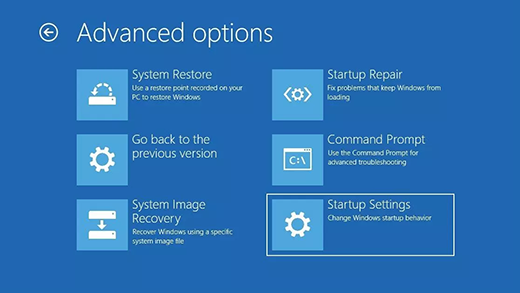- Start your PC in safe mode in Windows 10
- 6 Ways To Boot Windows 10 Into Safe Mode
- #1. Access safe mode from Windows 10 Settings
- #2. Use a Command prompt command
- #3. Access safe mode from the sign-in screen
- #4. Enable Safe mode in System Configuration
- #5. Force Windows to enter WinRE
- #6. Use a Windows 10 bootable USB or disk
- Bonus method
- Wrapping up
- Загрузка компьютера в безопасном режиме в Windows 10
Start your PC in safe mode in Windows 10
Safe mode starts Windows in a basic state, using a limited set of files and drivers. If a problem doesn’t happen in safe mode, this means that default settings and basic device drivers aren’t causing the issue. Observing Windows in safe mode enables you to narrow down the source of a problem, and can help you troubleshoot problems on your PC.
There are two versions of safe mode: Safe Mode and Safe Mode with Networking. Safe Mode with Networking adds the network drivers and services you’ll need to access the Internet and other computers on your network.
Select from the following sections to find out how to start your PC in safe mode from Settings, from the sign-in screen, or from a black or blank screen.
Press Windows logo key + I on your keyboard to open Settings. If that doesn’t work, select the Start button, then select Settings .
Under Advanced startup, select Restart now.
After your PC restarts to the Choose an option screen, select Troubleshoot > Advanced options > Startup Settings > Restart. You may be asked to enter your BitLocker recovery key.
After your PC restarts, you’ll see a list of options. Select 4 or press F4 to start your PC in Safe Mode. Or if you’ll need to use the Internet, select 5 or press F5 for Safe Mode with Networking.
When you can’t open Settings to get into safe mode, restart your device from the Windows sign-in screen.
On the Windows sign-in screen, press and hold the Shift key while you select the Power > Restart .
After your PC restarts to the Choose an option screen, select Troubleshoot > Advanced options > Startup Settings > Restart. You may be asked to enter your BitLocker recovery key.
After your PC restarts, you’ll see a list of options. Select 4 or F4 to start your PC in safe mode. Or if you’ll need to use the Internet, select 5 or F5 for Safe Mode with Networking.
Note: If you’ve encrypted your device, you’ll need your BitLocker key to start in safe mode.
Before you enter safe mode, you need to enter the Windows Recovery Environment (winRE). To do this, you will repeatedly turn your device off, then on:
Hold down the power button for 10 seconds to turn off your device.
Press the power button again to turn on your device.
On the first sign that Windows has started (for example, some devices show the manufacturer’s logo when restarting) hold down the power button for 10 seconds to turn off your device.
Press the power button again to turn on your device.
When Windows restarts, hold down the power button for 10 seconds to turn off your device.
Press the power button again to turn on your device.
Allow your device to fully restart. You will enter winRE.
Now that you are in winRE, you will follow these steps to take you to safe mode:
On the Choose an option screen, select Troubleshoot > Advanced options > Startup Settings > Restart.
After your device restarts, you’ll see a list of options. Select option 5 from the list or press F5 for Safe Mode with Networking.
If you need more info on a black or blank screen error, see Troubleshoot black or blank screen errors.
Notes: If you need to exit safe mode, simply restart your device, or:
Press the Windows logo key + R.
Type msconfig in the Open box and then select OK.
Select the Boot tab.
Under Boot options, clear the Safe boot checkbox.
6 Ways To Boot Windows 10 Into Safe Mode
Whether you have messed up Windows configuration or a virus prevents you from using the system, Windows safe mode is your best bet to solve all such problems.
In safe mode, Windows starts with minimum required drivers and services, and no third-party programs are loaded. This ensures no problematic program loads so that you may solve the problem without any interference.
However, accessing safe mode is a real problem when an error arises. Although it’s easier to access safe mode right from the Windows 10 settings, what if you can’t access the settings?
Or worse, you can’t even start Windows?
There are many ways to boot into safe mode in Windows 10, and each method is useful depending on the problem you are dealing with. In this article, I will show you 6 ways to access Windows 10 safe mode, so you may always have access to safe mode no matter the odds.
#1. Access safe mode from Windows 10 Settings
This is the most common method to access safe mode when you can operate the system and access the settings. Here’s how to do it:
Go to Windows Settings from the Start menu and click on Update & Security .
Now click on the Recovery option in the left panel and then click on Restart now button under the Advanced startup section.
Windows will restart and open up the Windows Recovery Environment (WinRE). Here go to Troubleshoot > Advanced options > Startup Settings > Restart.
Your PC will restart and open up a page with a bunch of commands to choose from. Here press the 4 key or f4 key to launch Safe mode.
#2. Use a Command prompt command
If you can only access the Command prompt, you can run a command that will restart the PC into Windows Recovery Environment, where you can access the safe mode.
To access the Command prompt in Windows 10, press Windows+R keys to open the Run dialog and type cmd here to open the Command prompt.
Here enter the command shutdown.exe /r /o and press the Enter key.
After a short delay, Windows will restart into Windows Recovery Environment, where you can follow the instruction in the above method to access safe mode.
#3. Access safe mode from the sign-in screen
You can also boot into safe mode from the sign-in screen if you cannot sign-in for some reason. All you have to do is click on the Power button at the bottom-right corner and then hold the shift key while clicking on the Restart button.
This will restart the PC, and you will enter the Windows Recovery Environment. You can follow the instructions in the first method to access safe mode from here.
Note: You can also use this method while inside Windows; hold the Shift key while restarting your PC from the Start menu.
#4. Enable Safe mode in System Configuration
This is a rather permanent option for accessing the safe mode, but it can help restart the PC often and make sure you always enter the safe mode. From System configuration, you can force the PC to always launch in safe mode whenever you restart. And when you are done fixing the problem, you can disable this option to get back to normal Windows. Here’s how to do it:
Press Windows+R keys to open the Run dialog and type msconfig here to launch the System Configuration window.
Here move to the Boot tab, check the checkbox next to Safe boot, and then click on OK.
You will be prompted to restart the PC, accept the prompt, and your PC will boot into safe mode on every restart now.
To undo the changes, follow the same steps as above while in safe mode and uncheck the checkbox next to Safe boot.
#5. Force Windows to enter WinRE
You can also force Windows to enter the Windows Recovery Environment from where you can access safe mode. This method should only be used in critical circumstances when Windows is unable to boot at all. Otherwise, this method can damage your Windows.
If Windows crashes three consecutive times, then it will automatically boot into WinRE. So if you are having trouble starting Windows, you can also fake crash the Windows to open up WinRE to solve it.
Just start the PC, and when Windows starts loading, hold the power button for up to 10 seconds to force it to shutdown. Repeat this process up to two times more, and the next time Windows will automatically boot into Windows Recovery Environment. From there, you can follow the guidelines in the first method to access safe mode.
#6. Use a Windows 10 bootable USB or disk
If you have your Windows 10 CD with you or a bootable Windows 10 flash drive, you can use it to boot into safe mode. You will only need to use this method when Windows is corrupted to the point it is unable to load at all, even the force shutdown method isn’t working.
If you don’t already have a bootable drive with you, you can easily create one for free using Windows 10 media creation tool. All you need is another PC and a USB drive with at least 8GB of free space. You can follow the instruction on the aforementioned Microsoft support page to download and create Windows 10 bootable USB.
Once you have the bootable drive, please insert it into the PC and start the PC. First, you will have to select the keyboard layout and preferred language. Once done, you can click on the Repair your computer button at the bottom-left corner of the window to open the Windows Recovery Environment.
The changes you make here in Windows Recovery Environment will apply to your original Windows. So all you need to do is access the safe mode from here (see method #1), and your corrupted Windows will launch in safe mode.
Bonus method
This method will probably not work on the latest PCs that run UEFI and have SSDs for storage. However, if you have an old PC with legacy BIOS with HDD storage, it should work for you; and it’s arguably the easiest method to access safe mode.
On Windows 7, you could access safe mode by repeatedly hitting the F8 or Shift+F8 keys before the Windows started. However, this method doesn’t work on Windows 8.1 and Windows 10 because the hardware they come with is new, and their boot time is swift. So there isn’t enough time for Windows to register the keystrokes and launch the safe mode.
Although if you have an old PC running on legacy BIOS and HDD, it will be slow enough even on Windows 10 to register the keystrokes and launch safe mode. If your PC qualifies, all you have to do is press the F8 key repeatedly when your PC starts booting to boot into safe mode. If that doesn’t work, try holding the Shift key and repeatedly pressing the F8 key.
This method is much faster to access safe mode as you don’t have to access Windows and don’t need to go through any menus.
Wrapping up
I am sure these methods to access safe mode in Windows 10 are enough no matter which problem you are stuck in. Whether you have access to Windows or not, one of these methods will work. Although if you are looking for the quickest way to open safe mode, I believe the 3rd method is the fastest. You don’t even have to sign-in to open safe mode, and it works even when you are signed-in.
If you still need help with the PC boot then check out Tenorshare Windows Boot Genius software.
Next, find out how to disable NetBIOS over TCP/IP in Windows.
Загрузка компьютера в безопасном режиме в Windows 10
В безопасном режиме запуск Windows выполняется с использованием ограниченного набора файлов и драйверов. Если проблема не возникает в безопасном режиме, это означает, что эти параметры по умолчанию и основные драйверы устройств не приводят к возникновению проблемы. Наблюдение за Windows в безопасном режиме позволяет сузить источник проблемы и устранить неполадки на компьютере.
Существует две версии безопасного режима: Безопасный режим и Безопасный режим с загрузкой сетевых драйверов. В безопасном режиме с поддержкой сети добавляются сетевые драйверы и службы, необходимые для доступа к Интернету и другим компьютерам в сети.
Изучите следующие разделы, чтобы узнать, как запустить компьютер в безопасном режиме в разделе «Параметры», на экране входа в систему, на черном или пустом экране.
Нажмите клавишу с логотипом Windows + I на клавиатуре, чтобы открыть раздел «Параметры». Если это не поможет, нажмите Start кнопку «Пуск» и выберите » Параметры «.
В разделе Особые варианты загрузки выберите элемент Перезагрузить сейчас.
После перезагрузки компьютера на экране Выберите параметр выберите элементы Диагностика > Дополнительные параметры > Параметры загрузки > Перезапуск. Возможно, вам будет предложено ввести ключ восстановления BitLocker.
После перезагрузки компьютера вы увидите список параметров. Нажмите клавиши 4 или F4, чтобы запустить компьютер в безопасном режиме. Если вам будет нужен Интернет, выберите клавиши 5 или F5, чтобы войти в безопасный режим с загрузкой сетевых драйверов.
Если вам не удается открыть «Параметры» для перехода в безопасный режим, перезагрузите устройство на экране входа в Windows.
На экране входа в Windows удерживайте клавишу SHIFT и выберите в это время Выключение > Перезапуск .
После перезагрузки компьютера на экране Выберите параметр выберите элементы Диагностика > Дополнительные параметры > Параметры загрузки > Перезапуск. Возможно, вам будет предложено ввести ключ восстановления BitLocker.
После перезагрузки компьютера вы увидите список параметров. Нажмите клавиши 4 или F4, чтобы запустить компьютер в безопасном режиме. Или, если вам нужно использовать Интернет, выберите 5 или F5 для безопасного режима с помощью сети.
Примечание: Если вы зашифровали свое устройство, для запуска в безопасном режиме вам потребуется ключ BitLocker.
Перед входом в безопасный режим необходимо войти в среду восстановления Windows (winRE). Для этого вы будете периодически включать свое устройство, а затем:
Нажмите кнопку питания на устройстве и удерживайте ее нажатой в течение 10 секунд, чтобы выключить устройство.
Снова нажмите кнопку питания, чтобы включить устройство.
После появления первого признака запуска Windows (например, на некоторых устройствах отображается логотип производителя при перезапуске) удерживайте нажатой кнопку питания в течение 10 секунд, чтобы отключить устройство.
Снова нажмите кнопку питания, чтобы включить устройство.
После перезагрузки Windows удерживайте кнопку питания на устройстве нажатой в течение 10 секунд, чтобы выключить устройство.
Снова нажмите кнопку питания, чтобы включить устройство.
Разрешите полностью перезапустить устройство. Будет активирована среда восстановления Windows.
В среде winRE выполните следующие действия, чтобы перейти в безопасный режим.
На экране Выбор действия выберите Диагностика > Дополнительные параметры > Параметры загрузки > Перезагрузить.
После перезагрузки устройства вы увидите список параметров. Выберите параметр 5 в списке или нажмите клавишу F5, чтобы запустить безопасный режим с подключением к сети.
Если вам нужны дополнительные сведения о черном или пустом экране, изучите раздел Устранение ошибок типа «черный» или «пустой» экран.
Примечания: Если вам необходимо выйти из безопасного режима, просто перезагрузите устройство или выполните следующие действия.
Нажмите клавишу с логотипом Windows+ R.
Введите msconfig в поле Открыть, а затем нажмите кнопку ОК.
Откройте вкладку Загрузка.
В разделе Параметры загрузки снимите флажок Безопасный режим.



















